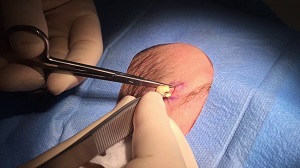Skin surgery, also known as dermatologic surgery or dermatologic procedures, refers to a range of surgical techniques used to diagnose, treat, or remove skin conditions, lesions, tumors, or cosmetic concerns. Skin surgery may be performed for medical, therapeutic, or aesthetic purposes. Here are some common types of skin surgeries:
- Excision: This involves cutting out a skin lesion or tumor, such as a mole, cyst, or skin cancer. The surgeon carefully removes the abnormal tissue along with a margin of healthy skin to ensure complete removal.
- Mohs Surgery: Mohs micrographic surgery is a precise technique used to remove certain types of skin cancer, particularly those with high recurrence rates or located in critical areas. It involves removing thin layers of skin and examining them under a microscope until no cancer cells are detected.
- Skin Biopsy: A skin biopsy involves the surgical removal of a small piece of skin for diagnostic purposes. It helps in the evaluation of suspicious lesions, skin conditions, or rashes to determine the underlying cause or confirm a diagnosis.
- Cryosurgery: Cryosurgery utilizes extreme cold temperatures to freeze and destroy abnormal skin cells or lesions, such as warts, actinic keratoses, or small skin cancers. Liquid nitrogen is commonly used in this procedure.
- Skin Grafting: Skin grafting involves taking healthy skin from one area of the body (donor site) and transplanting it to an area where the skin is damaged, such as burn wounds, extensive skin loss, or non-healing ulcers. It helps in promoting healing, reducing scarring, and restoring functionality.
- Laser Surgery: Laser surgery employs focused beams of light to precisely remove or treat various skin conditions, including birthmarks, scars, tattoos, and unwanted hair. It can also help in skin resurfacing, improving skin tone, and treating certain vascular conditions.
- Cosmetic Skin Procedures: Various cosmetic skin surgeries are performed to enhance appearance, reduce signs of aging, or improve skin texture. These may include facelifts, blepharoplasty (eyelid surgery), liposuction, and skin tightening procedures.
It’s important to consult with a qualified dermatologist or plastic surgeon to discuss the specific procedure, its benefits, potential risks, and the expected outcome. They will assess your individual condition, provide appropriate recommendations, and guide you through the pre-operative and post-operative care to ensure optimal results and minimize complications.

